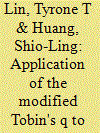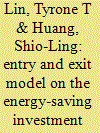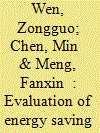| Srl | Item |
| 1 |
ID:
101411


|
|
|
|
|
| Publication |
2011.
|
| Summary/Abstract |
This paper is to develop a modified Tobin's q evaluation method which successfully combines the evaluation criteria of the traditional Tobin's q and the real options. This study provides flexible thinking for decision making criteria. That is, it clearly provides decision-makers with a reference in choosing enter or exit strategies, such as quantitative indicators references. The proposed model introduces two variables stochastic process in continuous time and explores the impact of the occurrence of unexpected events on the project value, so that, it can more authentically response to the project value. The studied issue deals with the firms that have not established energy-saving equipment yet. It attempts to figure out the optimal timing to adopt an energy-saving investment project when it is beneficial and the optimal timing to terminate it when the continuous operation of that business is unprofitable. The future discounted benefit-cost ratio, Q, follows the geometric Brownian motion with the Poisson jump process and the replacement of investment equipment. Except for the evaluation of energy-saving equipment investment project, the proposed model can be applied to other related project evaluation issues, such as energy-saving, CO2 emission reduction, or general investment projects.
|
|
|
|
|
|
|
|
|
|
|
|
|
|
|
|
| 2 |
ID:
094223


|
|
|
|
|
| Publication |
2010.
|
| Summary/Abstract |
This paper presents an improved decision model based on the real options approach presented by for the firms that have not yet established energy-saving equipment under the entry and exit strategies. Furthermore, the proposed model takes account of the inevitable equipment renewal and the occurrence of unexpected events under the Poisson jump process. The timing for terminating an investment when continuous operations of that business are unprofitable is also explored to realize the optimal timing of implementing the energy-saving strategy. The future discounted benefit B follows the geometric Brownian motion with the Poisson jump process and the replacement of investment equipment. A numerical analysis is followed by a sensitivity study of various parameters to better realize their impacts on the entry and exit thresholds. The results show that for the jump case, the higher probability of occurrence of unfavorable events will result in a higher entry threshold and lower exit threshold. Investors are forced to request higher benefit thresholds to cover the higher probability of losses brought by unfavorable events.
|
|
|
|
|
|
|
|
|
|
|
|
|
|
|
|
| 3 |
ID:
137702


|
|
|
|
|
| Summary/Abstract |
Much of China's cement industry still uses outdated kilns and other inefficient technologies, which are obstacles to improving energy efficiency. Huge improvements in energy consumption intensity can be made by improving this technology. To evaluate the potential for energy-saving and CO2 emissions reduction in China's cement industry between 2010 and 2020, a model was developed based on the Asian-Pacific Integrated Model (AIM). Three scenarios (S1, S2 and S3) were developed to describe future technology policy measures in relation to the development of the cement industry. Results show that scenario S3 would realize the potential for CO2 emissions mitigation of 361.0 million tons, accounting for 25.24% of the predicted emissions, with an additional energy saving potential of 39.0 million tons of coal equivalent by 2020. Technology promotion and industrial structure adjustment are the main measures that can lead to energy savings. Structural adjustment is the most important approach to reduce the CO2 emissions from the cement industry; the resulting potential for CO2 emissions reduction will be increasingly large, even exceeding 50% after 2016.
|
|
|
|
|
|
|
|
|
|
|
|
|
|
|
|